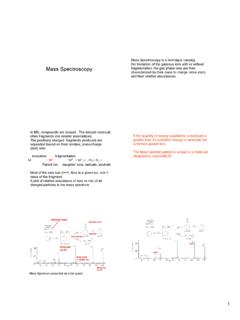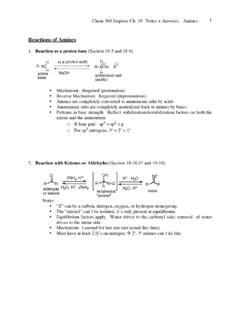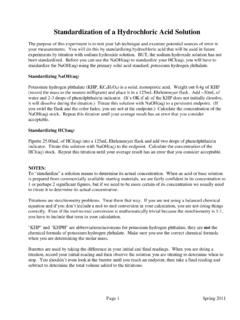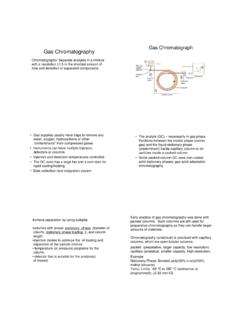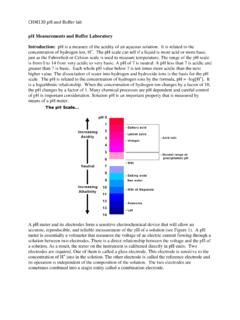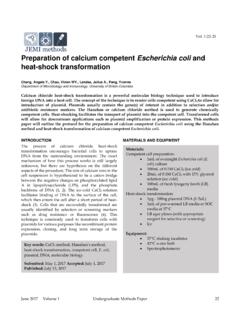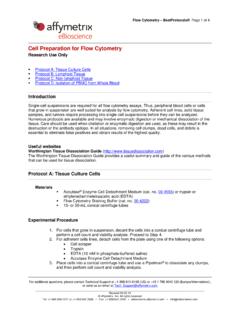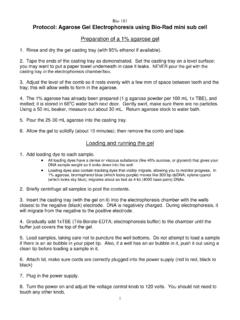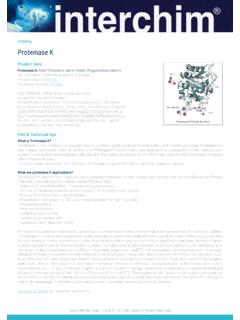Transcription of General Chemistry II Jasperse Buffers/Titrations ...
1 1. General Chemistry II Jasperse Buffers/Titrations /Solubility. Extra Practice Problems General Types/Groups of problems: T Buffers General p1 Titration Graphs and Recognition p10. What Kind of Solution/pH at End? p2 Titration Calculations p11. preparation and Recognition of Buffers p4 pH Estimations/Calculations after acid/base p12. are added (including at Equivalence Point). buffer Calculations p5 Solubility Problems p14. Disrupted Buffers: After Acid or Base are Added p7 Impact on Solubility When Common Ions p16. are Present Titration-Related Problems p9 Impact of pH on Solubility p17. Key Equations Given for Test: For weak acids alone in water: For weak bases alone in water: [H+] = K a x[WA] [OH-] = K b x[WB]. pZ= -logZ pH + pOH = 14. General definition for p of anything [H ][HO-] = x 10-14. + KaKb= x 10-14 for conjugate acid/base pair For buffer : . pH = pKa + log[base]/[acid] S (reactants).
2 S = S (products). Henderson-Hasselbalch Equation G = G (products) G (reactants) G = H T S (T in Kelvin). T. BUFFERS. 1. A solution that contains a weak acid and its conjugate base in roughly equal concentrations is _____. a. neither acidic or basic. d. a heterogeneous mixture. b. a half-acid solution. e. neutral. c. a buffer . 2. Explain how a buffer solution manages to stabilize the pH against the addition of acid, base, or additional solvent (dilution). Answer: A buffer consists of a weak acid and its conjugate base in roughly equal amounts. If acid is added to the solution, it is consumed by the conjugate base. If base is added to the solution, it is consumed by the weak acid. If the amounts are such that the ratio of conjugate base/weak acid concentrations doesn't change much, then the pH. doesn't change much. Dilution does not affect the pH because this concentration ratio doesn't change upon dilution.
3 3. Research with biochemical systems commonly requires buffers because _____. T a. that's just the way it is. b. proteins have a critical pH dependence in their structure and function. c. proteins decompose into constituent amino acids outside a certain pH range. d. proteins are buffers. e. salts are involved. 4. What reaction occurs as a hydrochloric acid solution is added to a solution containing equal concentrations of acetic acid and sodium acetate? a. CH3 COOH + H+ CH3 COOH2+ d. 2CH3 COO + 2H+ CH3 COO + H2. b. CH3 COO + H+ CH3 COOH e. CH3 COOH + H+ CH3CO+ + H2O. c. CH3 COOH + HCl CH3 COO + H2Cl+. 2. What kind of Solution/pH Do you Get at the End? How does Solution Change? 5. When the following chemicals are mixed, each in 1 liter of water, which would give an acidic pH at the end? T a) 1 mole of KOH and 1 mole of NaF. b) 1 mole of NH4+ and 1 mole of NaOH. c) 1 mole of HCl and 1 mole of NH3.
4 D) 1 mole of KOH and mole of HCl 6. When the following chemicals are mixed, each in 1 liter of water, which would give a basic pH at the end? a) 1 mole of KOH and 1 mole of HF. b) mole of KOH and mole of HCl c) 1 mole of HCl and 1 mole of NH3. d) mole of KOH and mole of HCl 7. When the following chemicals are mixed, each in 1 liter of water, which would give a basic pH at the end? a) 1 mole of KOH and 1 mole of HF. b) mole of KOH and mole of HCl c) 1 mole of HCl and 1 mole of NH3. T d) mole of KOH and mole of HCl 8. Consider a solution initially containing mol fluoride anion and mol of hydrogen fluoride (HF). If mol of HCl are added to this solution, which of the following statements is FALSE? a) You will still have a buffer solution at the end, since you'll still have both weak base and conjugate weak acid b) The pH will have shifted to a lower pH. c) You'll have more moles of HF at the end than what you began with d) You will no longer have a buffer solution, since all of the weak base will have reacted with the HCl.
5 E) none of the above 9. Consider a solution initially containing mol fluoride anion and mol of hydrogen fluoride (HF). If mol of HCl are added to this solution, which of the following statements is FALSE? T a) You will still have a buffer solution at the end, since you'll still have significant amounts of both weak base and conjugate weak acid b) The pH will have shifted to a lower pH. c) You'll essentially have a weak acid solution situation, with mol HF at the end. d) You will no longer have a buffer solution, since all of the weak base will have reacted with the HCl. The buffer capacity was exhausted. e) none of the above 3. 10. Consider a solution initially containing mol fluoride anion and mol of hydrogen fluoride (HF). If mol of NaOH are added to this solution, and the final volume is 1L, which of the following statements is FALSE? a) You'll essentially have a strong base solution at the end, with mol NaF but with mol NaOH at the end.
6 The T moles of strong base will essentially dictate the pH. b) The pH will have shifted to a higher, more basic pH. c) The final pH will be 13. d) The final pH will be dominated by the NaF, so I'd need the Kb or pKb in order to solve for the pH. e) none of the above 11. Consider a solution that contains moles of KF and moles of HF in L of water. If mol of NaOH is added to this buffer solution, the pH of the solution will get slightly . The pH does not change more drastically because the NaOH reacts with the present in the buffer solution. a) higher, KF. b) higher, HF. c) lower, KF. d) lower, HF. T 12. Consider a solution that contains moles of NaNO2 and moles of HNO2 in L of water. If mol of HCl is added to this buffer solution, the pH of the solution will get slightly . The pH does not change more drastically because the NaOH reacts with the present in the buffer solution. a) higher, NaNO2.
7 B) higher, HNO2. c) lower, NaNO2. d) lower, HNO2. 13. Identify all the correct statements about an acid base buffer solution. I. It can be prepared by combining a strong acid with a salt of its conjugate base. II. It can be prepared by combining a weak acid with a salt of its conjugate base. III. It can be prepared by combining a weak base with its conjugate acid. IV. The pH of a buffer solution does not change when the solution is diluted. V. A buffer solution resists changes in its pH when an acid or base is added to it. a. I, II, and IV d. I, II, IV, and V. b. II, III, and V e. II, III, and IV. T c. II, III, IV, and V. 4. preparation and Recognition of buffer Systems 14. Which of the following is not a buffer system? A solution containing roughly equal concentrations of _____. a. fluoride ion and hydrofluoric acid. WB + WA. T b. bromide ion and hydrobromic acid. non-base + Strong acid c.
8 Phosphate ion and hydrogen phosphate ion. WB + WA. d. carbonate ion and hydrogen carbonate ion. WB + WA. e. phosphoric acid and dihydrogen phosphate ion. WA + WB. 15. Which of the following can be mixed together in water to produce a buffer solution? a. HClO4 and NaClO4 SA + neutral d. H3PO4 and NaH2PO4 WA + WB. b. HNO3 and NaNO3 SA + neutral e. HCl and NaCl SA + neutral c. H2SO4 and NaHSO4 SA + WA. 16. Which one of the following would make the best buffer ? (Ac = acetate, CH3CO2). a. a solution of hydrochloric acid and sodium chloride, HCl and NaCl SA + neutral b. a solution of acetic acid and ammonia, NaAc and NH3 WB + WB. c. a solution of acetic acid and ammonium chloride, HAc and NH4Cl WA + WA. d. a solution of sodium acetate and ammonium chloride, NaAc and NH4Cl WB + WA but NOT conjugates e. a solution of ammonia and ammonium chloride, NH3 and NH4Cl WB + WB and Conjugates T. 17.
9 Which combination of solutions is the best choice for making a buffer solution? WB + WA a. equal volumes of 1 M ammonia (NH3) and M ammonium chloride (NH4Cl). SA + SB b. equal volumes of M hydrochloric acid (HCl) and M sodium hydroxide (NaOH). SA + neut c. equal volumes of M hydrochloric acid (HCl) and M sodium chloride (NaCl). WA + WB d. equal volumes of 2 M ammonia (NH3) and 1 M hydrochloric acid (HCl). WA + SA e. equal volumes of 2 M ammonium chloride (NH4Cl) and 1 M hydrochloric acid (HCl). 18. Which of the following would be the best choice for preparing a buffer with a pH = a. a solution of formic acid and sodium formate, Ka = 10 4. b. a solution of acetic acid and sodium acetate, Ka = 10 5. c. a solution of hypochlorous acid and sodium hypochlorite, Ka = 10 8. d. a solution of boric acid and sodium borate, Ka = 10 10. e. All of these solutions would be equally good choices for making this buffer .
10 19. When placed in 1 L of water, which of the following combinations would give a buffer solution? (Remember, in some cases they might react with each other ). T 1) mol HClO and mol NaClO. 2) mol HBr and mol NaF. 3) mol HBr and mol NaF. 4) mol HBr and mol NaOH. a) 1 only b) 1 and 2 only c) 1 and 3 only d) 3 and 4 only e) all would give buffer solutions 5. buffer Calculations 20. Calculate the pH of a solution that is M in ammonia (NH3) and M in ammonium chloride (NH4Cl, Ka = 10 10). Steps: T 1. Recognize: WA + WB = buffer Answer: 2. Solve: HH equation Finding pH 3. Need: pKA. 4. Check: Does it make sense? -pH is close to pKa, basic side 21. Calculate the pH of a solution containing mol fluoride anion and mol of hydrogen fluoride (HF). (HF, Ka =. 10 4)? a) mol Steps: b) mol 1. Recognize: WA + WB = buffer c) mol 2. Solve: HH equation d) mol 3. Need: pKA. e) none of the above 4. Check: Does it make sense?


